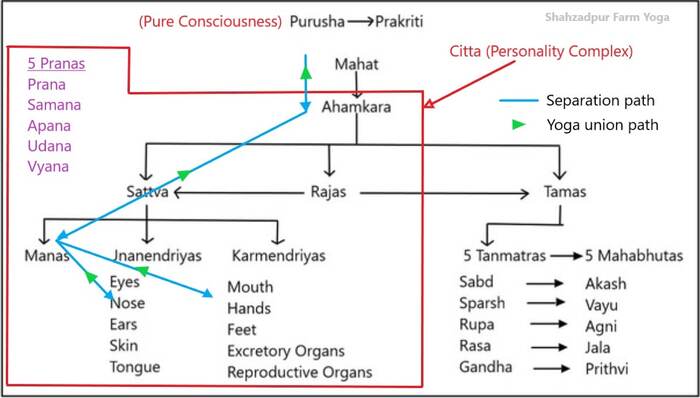Author: Randeep Singh / go to all articles on Yoga Concepts

Most of the materially progressive inhabitants of the planet earth, today, carry a very foggy vision of the ancient philosophy and technology known as Yoga.
If you ask a lay man, what is yoga? You will get to peep into the variegated images of it hanging inside his mind.
For some it is a practice of body postures akin to any other form of exercise, other believe that it is meditation and pranayama,
and still for some it is the latest fad in the fitness industry which has smitten every adherent of the sect who believes in achieving good looks is primary to achieving success in any area of life.
Infact, Sadguru, in one of his blogs has clearly demystified some basic myths about the meaning of yoga.
In case someone is adamant enough to further research on the real meaning of this concept shrouded in mystery, one can look up on the internet (majorly loaded with the history and types in the name of its meaning), which variably puts forth its literal meaning as ” the union.” Union of what? The union of two unrelated entities, or of something that was “one” but got separated later on. Why is this union required? what is Yoga, finally?
The main reason for the present generation loosing upon the real meaning of yoga is that, today, this ancient wisdom, knowledge is being only marketed as the techniques of it, and not the philosophy.
West has dissected it into multiple commercial commodities (power yoga, bear yoga, hot yoga…….) based on the different personal likings of their prospective customers, which are in turn based on their flimsy understanding of this profound wisdom, shamelessly being marketed around the globe. Not only in West, even in India the pace of commercializing yoga is picking up everywhere, Rishikesh is an apt example for the same.
Another section of society receives an introduction to yoga, from their doctor’s, for the ones who suffer from various ailments, as a slow but last resort for healing their ailing bodies. Even Yoga guru Baba Ramdev , who has been extremely instrumental in popularizing yoga across all levels of society, is seen only popularizing the therapeutic aspects of this ancient science and philosophy.
Ok, very much understandable! He offers people what they want to hear and ask for. Philosophy can be boring to first understand, forget about weaving it in one’s daily life. Can just the knowledge and practice of techniques of yoga suffice one’s need to lead a meaningful and healthy life, or does one also need to understand, imbibe the philosophical strands entwined around them?
Let us understand this by delving deeper into the real meaning of Yoga.
The real meaning of Yoga
Samkhya and Yoga are the two philosophies out of the total six Vedic philosophies of ancient India. Patanjali is the compiler of The Classical Yoga Sutras, which form his complete compilation on Yoga, Known as Ashtanga yoga.
This is the only form of yoga that is original and authentic in its techniques and teachings, all the other forms, types of Yoga had emerged from it as the later Yoga Teachers began customizing its tenets as per the needs and likings of different cultures around the world.
Samkhya philosophy is older than Patanjali’s Yoga sutras and it explains the evolution of the universe, from two basic entities: Pure Consciousness (Purusha) and the subtlest form of matter known as Prakriti.
It explains metaphysically, step by step, process of emergence of the five basic elements – Panchmahabhutas – from these two main entities. The entire animate and inanimate objects of the universe are made out of the various products (entities) at various levels along this chain of evolution of the universe, beginning from the coming together of the Pure Consciousness and Prakriti.
Patanjali had later grafted the metaphysics of Samkhya on to the yoga system. Yoga asanas, pranayamas, yoga kriyas, and parikarmas already existed before Patanjali, he probably brought meaning to these techniques and provided them a philosophical base with the help of Samkhya.
It is even suggested that the evolutionary scheme of tattwas (elements) available in the Samkhya Yoga system have been so arranged after yogic perception of them during Samadhi. To a good extent, therefore, Yoga is not merely a speculative affair, but is rather based on the solid foundations of direct intuitive observations.
Samkhya on the Separation that needs to be Reunited (Yoga)
The evolution of Prakriti into a sentient being is depicted in the graphic below. This process clearly helps answer the question ‘What is Yoga?.’ To know the details of the process, as explained, one can go to the article linked to above, here we will focus more on the separation and union of the entities involved.

As you can see in the infographic, Pure Consciousness (Purusha) and Prakriti come near to each, for a purpose, and the first evolute which emerge from this combination is the Mahat, or the intelligence principle.
From Mahat emerges Ahamkara, or the ego principle, which propagates self identity, sense of individuality which instills the sense of being a separate entity, separate from everything else, within the individual.
From the Sattvic Ahamkara emerges the mind (manas), ten sense organs {the five senses of perception (jnanendriyas), and the five senses of action (karmendriyas)}. The Tamasic aspects of Ahamkara condenses into five Tanmatras which finally evolve into five basic elements (Mahabhutas) out of which the entire material universe is composed of.
In this scheme of evolution the complete individual is identified as Citta, or the personality complex which is formed of the 5 senses of perception, 5 senses of action, 5 pranas, mind, and Ahamkara.
One can clearly see in the graphic that the Citta is located quite away from the pure consciousness. This is because as the chain of evolution progresses downwards the matter content (Prakriti) of each evolute is more than the preceding one, and the conscious (purusha) content continues decreasing proportionately.
In other words, Prakriti (material matter) traps a section of the pure consciousness within it and begins to evolve into the universe at various levels. The lower the level the lesser the amount of consciousness in it.
Since Citta is the lowest product of the chain of evolution of Prakriti, it has the lowest proportion of consciousness, or a deep separation sets in between the trapped part of the consciousness and the pure consciousness at each level of evolution of the material world.
The domination of matter at this level is the cause of all pain, and issues at this level. In case one has to get rid of the three basic pains one has to reunite the Trapped part of the consciousness (soul within the individual) with the Pure Cconsciousness by completely dissolving the matter content at all the levels of the process of evolution.
This dissolving, purging, or cleansing of the matter (prakriti) for freeing the trapped consciousness is done with Yoga. Thus the union of the individual consciousness with the Pure Consciousness is Yoga. The question ‘ What is Yoga? ‘ stands answered here.
This union (yog in Sanskrit) leads to the liberation (moksha) of the soul from the clutches of matter.
Watch the video related to the same for more clarity.
Yoga in Yoga Sutras
Now let us know what is the meaning of Yoga as per the Yoga Sutras of Patanjali. Yoga sutras are rightly considered the grammar of spirituality. But, more than this, they also provide a very beautiful philosophical guideline. They provide direction to all spiritual efforts. Yoga sutras define yoga as the complete control of the modifications (fluctuations) of the Citta.
But, this is immediately followed by another sutra that completes the definition by answering the question “Why control the Citta?” Thus, Yoga is complete control of Citta so that the Pure Consciousness which is behind the Citta, and which gives meaning to all the activities of the Citta may become available.
” Then the seeker, practitioner of Yoga is established in its true nature, and the ultimate reality prevails.” This statement may sound philosophical by is also a experiential fact. As we analyze our normal consciousness we have two aspects; one is the object of our awareness and other is the awareness itself.
For example, when we are viewing the projection of a slide on the screen we see (become aware of) the black and white of the slide, but remain oblivious of the light coming from the slide projector which is actually responsible for the phenomenon.
The practice of the techniques of Ashtanga Yoga help still the mind by applying it, or concentrating it on an object. This is the technique of Samadhi, which when perfected helps one gain the highest knowledge of the experience of Pure Consciousness bereft of any matter.
This becomes possible because in the state of Samadhi the mind dissolves, as all its modifications are stopped, which in turn dissolves the associated Ahamkara and Intelligence blocking the path to experiencing Pure Consciousness, as can be discerned from the graphic above.
So that’s what Yoga Sutras tell about ‘What is Yoga.’
Other Different Meanings of Yoga
Different people have given different meanings to the word Yoga, the traditional meaning being to yoke. That which unites. To unite means, their is no otherness, there is only oneness. Onesses here means the Observer (Pure Consciousness) is the Observed (Pure Consciousness).
This means a state where the Pure Consciousness is observing itself, as now all the other entities – which could have been the obstacle to or objects of observation – have been dissolved by practicing yoga. All conflicts cease when one actually feels that the observer is the observed.
Some equate Yoga to meditation. Meditation is not concentration, because in concentration the big ‘I’ (Ahamkara) operates. There is no reward in meditation, you are not there in meditation. There cannot be pre-meditated meditation. As long as there is a meditator, who meditates, there is no meditation.
The ending of the ‘Me’ is meditation. In meditation there is complete release of energy, and complete exploitation of love. This love is not the opposite of hate, is not of one and not of the other, neither is this love any possession nor is it the lust.
Yoga means freedom, that which liberates. To be liberated while living here and now. Completely free from all conditioning. A conditioned mind can never explode nor explore. Freedom here does not imply permissiveness. This freedom demands extreme discipline. The Yogi means one who is jivanmukta, he has nothing to be achieved.
Yoga is as old as life itself. It is in essence a specific way, a manner of living. Basing its insights and techniques on the observations of nature, yoga imparts a certain quality to life. Yoga for example tells one how to sit, how to breathe, how to relax, how to feel, how to think, how to behave and how to grow to one’s full maturity.
It provides us with procedures that consistently help us in every area of one’s life. Yoga can thus be defined as an ancient system of self development that expedites man’s natural process of evolution in all departments of his life, with a special reference to the evolution of the consciousness.
Yoga is not just Physical – Asana and Pranayama
The most abused meaning of the word Yoga is asana and Pranayama. One often hears people saying ‘I am practicing Yoga’ while they are doing asana. Standing on one’s head or shoulders is also called Yoga.
Since Yoga means uniting back with the Pure Consciousness, or being aware of the Pure Consciousness or being able to experience Purusha, how does one achieve that. Patanjali had answered this question by laying out 8 consequent steps one need to follow in order to achieve this. He called these eight steps as the Ashtanga (eight parts) yoga.
These parts include Yamas, Niyamas, Asana, Pranayama, Pratyahara, Dharana, Dhyana, Samadhi. In order to achieve the goal of realizing one’s Pure Consciousness one need to begin with the first step and move to the next in the sequence they have been laid out in. One cannot jump these steps like just practicing Asana by cutting short on Yamas and Niyamas.
In fact, this is a sequence of purifying one’s mind. Only a purified mind can be still and thus get dissolved. Mind is considered the biggest hinderance in experiencing the Pure Consciousness as it keeps the owner entangled in the pains and pleasures of the material world.
Its the Citta, the entire personality complex which needs to be stopped and stilled, only then one can feel, experience the Pure Consciousness the Citta was keeping covered behind it. The eight steps of The Ashtanga Yoga help purify all the 17 components of the Citta so that it can rest in peace and shuts off its maze of activities it always remains entangled in.
We talk of mind instead of Citta because mind is the major component of Citta – All the 10 sense organs, and the five prananas constitutes the mind in different measures.
Yamas are the five things one should not do in order to generate more impurities in the Citta. Niyamas are the five disciplines or routines one must follow to generate more purity in the Citta. Asanas help purify the physical body which is the vessel into which the mind is kept held. The more pure and stable the vessel holding the mind will be the more still can the mind stay.
Pranayamas take care of the prana energy which is responsible for all the movement of the mind and the body. The more impure is the prana the more desynchronized will be these movements which will lead to unsteadiness in all these areas.
The biggest distractions to the mind are supplied to it by the sense organs as they constantly keep reading information from the outside world and projecting it on it. Pratyahara technique helps one to learn to withdraw the senses form their objects in order to help still, arrest the mind.
Ones the Purification of the physical, energetic, and mental fluctuations has been achieved the mind is ready to be trained for stilling itself by focusing it on a single thought or object. This is called Dharana (Concentration) in the scheme of eight steps of Yoga as proposed by Patanjali.
As one progresses on acing the act of concentration the mind begins to dissolve and fade away, as concentration has reduced the amount, number of signals it can receive, since mind is nothing but a matrix of thoughts created out of the signals received from the sense organs, it no more exists. This stage is known as Dhyana (meditation).
Finally all the entities present beyond the mind, Ahamkara (ego) and Mahat (ntelligence), also disappear and what is left is only Pure Consciousness, Now Pure Consciousness is aware of only itself, or become one with itself. Thus, the process of Yoga helps reverse the process of evolution of Prakriti and free the Consciousness from the trap of Prakriti (matter).
Conclusion:
Yoga is the union of the Individual consciousness (soul) with the Universal or Pure Consciousness. These two get separate in the process of evolution of Prakriti (matter) into the material universe which is the cause of all restlessness, and pain. The Eight Steps of Ashtanga Yoga help reverse this sequence of evolution and unites (yog in Sanskrit) the separated Individual Consciousness with the Universal Consciousness.
Read other Informative Articles….
Nuances of Teaching Yoga Online

